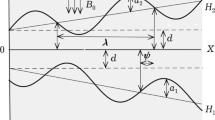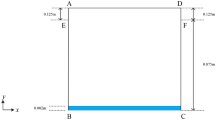Abstract
Numerical simulations on the pulsatile flow in stenosed tubes were conducted to investigate the effect of trapezium shape of stenosis on the flow field around stenoses. Four trapezium shapes of stenoses were considered by varying contraction, plateau, and expansion parts of stenoses for different stenosis area reduction ratios. The Galerkin finite element method based on the P2P1 mixed element was employed to solve the axisymmetric incompressible Navier-Stokes equations and the continuity equation. The proposed numerical method was validated by solving a benchmark problem of stenotic flow. It was found that the average pressure profile along the centerline was more affected by the contraction shape than the expansion shape. It was also revealed that the average wall shear stress of mild contraction was greater than that of sudden contraction around the stenotic region. Furthermore, the pressure drop across the stenosis was found to be associated with the form drag experienced by the stenosis.
Similar content being viewed by others
References
S. A. Ahmed and D. P. Giddens, Velocity measurements in steady flow through axisymmetric stenoses at moderate Reynolds numbers, Journal of Biomechanics, 16 (1983) 505–516.
M. Ojha, R. S. Cobbold, K. W. Johnston and R. L. Hummel, Pulsatile flow through constricted tubes: an experimental investigation using photochromic tracer methods, Journal of Fluid Mechanics, 203 (1989) 173–197.
M. K. Banerjee, R. Ganguly and A. Datta, Effect of pulsatile flow waveform and Womersley number on the flow in stenosed arterial geometry, ISRN Biomathematics (2012) 853056.
H. Jung, J. W. Choi and C. G. Park, Asymmetric flows of non-Newtonian fluids in symmetric stenosed artery, Korea-Australia Rheology Journal, 16 (2004) 101–108.
S. S. Varghese, S. H. Frankel and P. F. Fischer, Direct numerical simulation of stenotic flows, Part 2. Pulsatile flow, Journal of Fluid Mechanics, 582 (2007) 281–318.
S. Kamangar, G. Kalimuthu, I. A. Badruddin, A. Badarudin, N. J. Ahmed and T. M. Y. Khan, Numerical investigation of the effect of stenosis geometry on the coronary diagnostic parameters, The Scientific World Journal (2014) 354946.
M. V. Caruso, S. D. Rosa, C. Indolfi and G. Fragomeni, Computational analysis of stenosis geometry effects on right coronary hemodynamics, 2015 37th Annual International Conference of the IEEE (2015) 981–984.
D. Tang, C. Yang, S. Kobayashi, J. Zheng and R. P. Vito, Effect of stenosis asymmetry on blood flow and artery compression: A three-dimensional fluid-structure interaction model, Annals of Biomedical Engineering, 31 (2003) 1182–1193.
S. Kang, H. G. Choi and J. Y. Yoo, Investigation of unsteady fluid-structure interactions using a velocity-linked P2/P1 finite element method and the generalized-alpha method, International Journal for Numerical Methods Engineering, 90 (2012) 1529–1548.
Author information
Authors and Affiliations
Corresponding author
Additional information
Byoung-jin Jeon received a Ph.D. at Seoul National University of Science and Technology majoring in computational fluid dynamics based on finite element method. He is currently a Senior Research Engineer in the VD3 Team of LG Display, Korea.
Rights and permissions
About this article
Cite this article
Jeon, B.J., Chang, HJ., Yoo, YH. et al. A numerical study on the effect of trapezium stenosis shape on the axisymmetric flow field around stenosis. J Mech Sci Technol 32, 2651–2658 (2018). https://doi.org/10.1007/s12206-018-0522-0
Received:
Revised:
Accepted:
Published:
Issue Date:
DOI: https://doi.org/10.1007/s12206-018-0522-0




